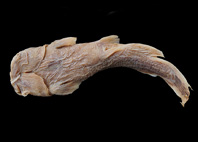Abstract
Left-eyed flounders of the genus Chascanopsetta Alcock 1894 (Bothidae) occur in the Indian, Pacific, and Atlantic oceans at depths ranging from 120 to 1500 meters. They possess some unique features in bothid fishes including a strongly compressed and elongated body and a tremendously large mouth. Currently, nine species of Chascanopsetta are recognized, and three of them (C. micrognatha Amaoka & Yamamoto 1984, C. lugubris Alcock 1894 and C. prognatha Norman 1939) are distributed in the West Pacific. We collected 25 specimens of Chascanopsetta during 11 biodiversity expeditions carried out mainly in the West Pacific. Among them, eight specimens taken off Papua New Guinea present morphological features that differ from those of the three nominal species known in the West Pacific. In this study, we examined these eight specimens of unknown affinity and compared their morphology to that of specimens of other congeneric species. Results of these comparisons showed that these specimens represent an undescribed species of Chascanopsetta, named herein, C. novaeguineae sp. nov.. The new species resembles C. elski Foroshchuk 1991, which is known only from the Saya de Malha Bank in the western Indian Ocean, in having a high number of gill rakers (> 13). However, the combination of the following characters further distinguishes C. novaeguineae sp. nov. from C. elski: longer jaws, narrower interorbital width, and number of pseudobranches (21–25 vs. 26–27). The DNA sequences from the mitochondrial cytochrome oxidase subunit I (COI) gene from C. novaeguineae sp. nov. and other species were obtained and compared to confirm its taxonomic status and to infer its tentative phylogenetic position within the Chascanopsetta.
References
Amaoka, K. (1969) Studies on the sinistral flounders found in the waters around Japan: taxonomy, anatomy and phylogeny. Journal of the Shimonoseki University of Fisheries, 18 (2), 65–40.
Amaoka, K. & Parin, N.V. (1990) A new flounder, Chascanopsetta megagnatha, from the Sala-y-Gomez Submarine Ridge, eastern Pacific Ocean (Teleostei: Pleuronectiformes: Bothidae). Copeia, 1990 (3), 717–722.
https://doi.org/10.2307/1446437Amaoka, K. & Yamamoto, E. (1984) Review of the genus Chascanopsetta, with the description of a new species. Bulletin of the faculty of fisheries Hokkaido University, 35 (4), 201–224.
Bruun, A.F. (1937) Chascanopsetta in the Atlantic; a bathypelagic occurrence of a flat-fish, with remarks on distribution and development of certain other forms. Videnskabelige Meddelelser fra Dansk Naturhistorisk Forening, Kjøbenhavn, 101, 125–136.
Chang, C.-H., Shao, K.-T., Lin, H.-Y., Chiu, Y.-C., Lee, M.-Y., Liu, S.-H. & Lin, P.-L. (2017) DNA barcodes of the native ray-finned fishes in Taiwan. Molecular Ecology Resources, 17 (4), 796–805.
https://doi.org/10.1111/1755-0998.12601Felsenstein, J. (1985) Confidence limits on phylogenies: an approach using the bootstrap. Evolution, 39 (4), 783–791.
http://dx.doi.org/10.1111/j.1558-5646.1985.tb00420.xForoshchuk, V.P. (1991) A new species of the genus Chascanopsetta from Saya de Malha Bank (Indian Ocean). Voprosy Ikhtiologii, 31 (1), 3–8.
Hensley, D.A. & Smale, M.J. (1997) A new species of the flatfish genus Chascanopsetta (Pleuronectiformes: Bothidae), from the coasts of Kenya and Somalia with comments on C. lugubris. The J.L.B Smith Institute of Ichthyology Special Publication, 59, 1–8.
Hubert, N., Hanner, R., Holm, E., Mandrak, N.E., Taylor, E., Burridge, M., Watkinson, D., Dumont, P., Curry, A., Bentzen, P., Zhang, J., April, J. & Bernatchez, L. (2008) Identifying Canadian Freshwater Fishes through DNA Barcodes. PLoS ONE, 3 (6), e2490.
https://doi.org/10.1371/journal.pone.0002490Kumar, S., Stecher, G. & Tamura, K. (2016) MEGA7: Molecular Evolutionary Genetics Analysis version 7.0 for bigger datasets. Molecular biology and evolution, 33 (7), 1870–1874.
https://doi.org/10.1093/molbev/msw054Munroe, T.A. (2003) Family Bothidae. In: Carpenter, K.E. (Ed.), The living marine resources of the Western Central Atlantic, Bony fishes. Part 2. FAO species identification guide for fishery purposes and American Society of Ichthyologist and Herpetologists Special Publication No. 5. Food and Agriculture Organization of the United Nations, Rome, pp. 1885–1895.
Rambaut, A. (1996) Se-Al: Sequence Alignment Editor. Available from: http://tree.bio.ed.ac.uk/software/seal/ (accessed 11 July 2018)
Stamatakis, A. (2014) RAxML version 8: a tool for phylogenetic analysis and post-analysis of large phylogenies. Bioinformatics, 30 (9), 1312–1313.
https://doi.org/10.1093/bioinformatics/btu033Ward, R.D., Zemlak, T.S., Innes, B.H., Last, P.R. & Hebert, P.D.N. (2005) DNA barcoding Australia’s fish species. Philosophical Transactions of the Royal Society B, 360 (1462), 1847–1857.
https://doi.org/10.1098/rstb.2005.1716

